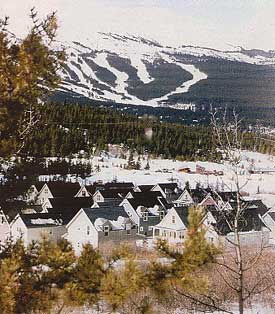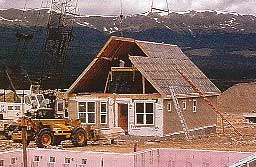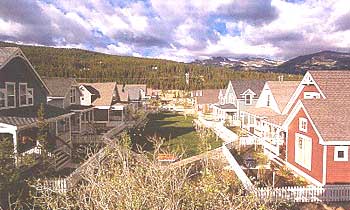Mountain Urbanism: Resort Neighborhood Creates Affordability Without Income Limits
by William P. Macht
Like many vacation communities, Breckenridge, Colorado, has become a magnet for second-home buyers--so much so that last year the median cost of a single-family home rose to $803,000. But what benefits builders and brokers can be bad news for full-time residents. Even those with incomes approaching $100,000 cannot afford a single-family home near town of 2,000 residents (20,000 in ski season). The result is Rocky Mountain sprawl. The high prices have sent workers 50 miles away to buy or to rent, and jobs in town now go begging.
 |
Though contiguous to Breckenridge, Colorado, Wellington, a new $25 million housing project geared toward full-time residents, is located in an edge-of-town setting with mountain vistas, southern exposure, and access to U.S. Forest Service trails. |
To satisfy Breckenridge's middle-income housing shortage, Boulder affordable housing developers David O'Neil, John Wolff, and Tom Lyon formed Poplarhouse, LLC, which is combining restrictions on resale price, but not on homebuyer income, with a new urbanist type of solution to create a sense of place. Wellington, a new $25 million project, offers only 24 of Wellington's 122 houses to second-home buyers at market rates. These are aimed at families who want to own a vacation home within a permanent community, so short-term rentals of less than six months are prohibited. The remaining 98 homes are available only to full-time residents who work in Summitt County. Pricing the residences at about $187 a square foot--which translates to $220,000 for a two-bedroom duplex and $281,000 for a single-family house with four-bedrooms--the developers devised a nongovernmental method to keep houses permanently affordable without any income-qualification restrictions. In exchange for receiving the "local price" (approximately $80,000 below market value), private deed restrictions limit resale appreciation to 3 percent a year, or to the percentage increase in the area median income (AMI), whichever is greater. In recent years, AMI has appreciated about 5 percent a year, in contrast, the average Breckenridge market-rate home has appreciated 10 to 15 percent a year. The deed restrictions are self-enforcing since the buyer executes a trust deed in favor of the town for excess sales prices. Therefore, resales cannot be closed without discharge of the underlying promissory note.
Wellington's first 23-acre parcel at the 85-acre site ultimately will include a mixture of single-family houses, attached houses, and live/work buildings. Another 40 acres await entitlement. A large portion of the entire site will be dedicated as public or private open space. Nearing completion, the 40 homes in the first section are placed in groups of ten that fave the four village greens. Connected at either end, these "green courts" are automobile-free, shared open spaces.
 Manufactured segments were shipped 500 miles to the site to be assembled and clad in hardboard siding with wood trim. The second floors, roof, exterior porches, and trim as well as interior finishes and painting were completed on site. |
Inexpensive land was crucial to creating a traditional, affordable neighborhood: land costs below $12,000 per acre were needed to make the numbers work, bu residential-zoned lots in Breckenridge typically sell for well over $200,000 an acre. The development team kept costs down by acquiring property in unincorporated Summit County. Though contiguous to Breckenridge, this is an edge-of-town setting with mountain vistas, southern exposure, and access to U.S. Forest Service trails. The town plans to create a circulator bus route and bike trails that will connect Wellington to downtown, 1.3 miles away.
Before construction began, the site consisted of piles of dredged rock left over from the Wellington-Oro Mine, Summit County's largest producer of gold, lead, and silver from 1887 to 1972. While this made for a bleak landscape initially, the dredge piles have made a workable subsurface for foundations. Most of Breckenridge is built on these piles.
A bigger challenge was the site's zoning, which allowed only four homes by right. In addition to bucking local antigrowth sentiment, the proposed neighborhood's setbacks, road widths, and minimum lot sizes were at odds with local land use regulations. After four years of intense public process, the town was persuaded to accept the development's requirement that buyers be local working residents. The town finally encouraged the project through indirect subsidies worth about $1 million. These included waiving of inspection, annexation, and development-review fees worth about $7,500 per unit, and of a 1 percent transfer tax worth approximately $2,500 per unit.
Design and planning details were modified for heavy snow conditions where expansive local street standards had been devised for snow plowing and storage. The development team argued for new urbanist-style narrow streets, ultimately settling on a reasonably narrow 20 feet. These streets intersect at right angles with alleys whose width the town wanted to be 70 feet. A compromised was reached at 18 feet of asphalt within a 36-foot right-of-way between garages for snow storage.
Builders at 9,600 feet above sea level face a short construction season. To compensate, Wellington's first-floor structural shells and mechanical systems were built in factories in Nebraska and Kansas. The standard factory modules were redesigned to accommodate 1.5-story massing, dormers, large front porches, and nine-foot ceilings--key elements to convey the scale and character of historic Breckenridge. Manufactured segments were shipped 500 miles to the site to be assembled and clad in hardboard siding with wood trim. Second floors, roof, exterior porches, exterior trim, interior finishes, and painting were completed on site. Although the manufacturing process is credited with providing more house for the money, cost savings were only about 5 percent under conventional stick framing, rather than the expected 20 percent.
The absorption rate at Wellington suggests that affordable, permanent resort housing in a traditional neighborhood can tap strong demand. Sales of both affordable homes and second homes (which are priced up to $375,000, or about $220 a square foot for 1,800 square feet) have been strong. Some 30 of 40 houses constructed have been sold and a number are now under contract. Private resale price deed restrictions, with no income limits, appear to be an innovation other developers and towns may want to emulate.
Will Macht is a professor of urban planning and development at Portland State University in Oregon and a development consultant. Comments about projects profiled in this column, as well as proposals for future profiles, should be directed to the author at willmacht@gorge.net.
Urban Land - November/December 2001













